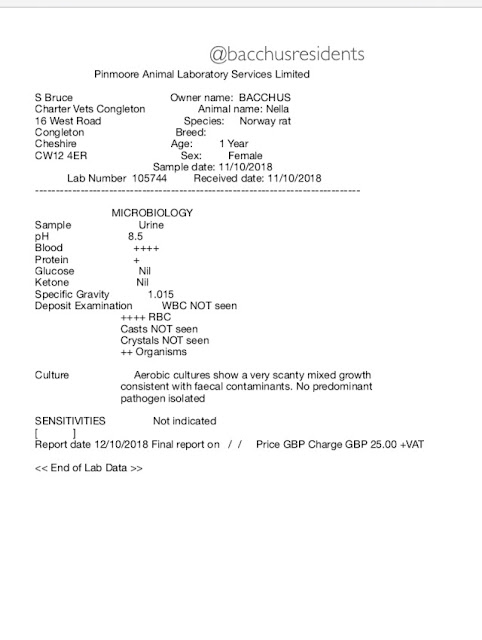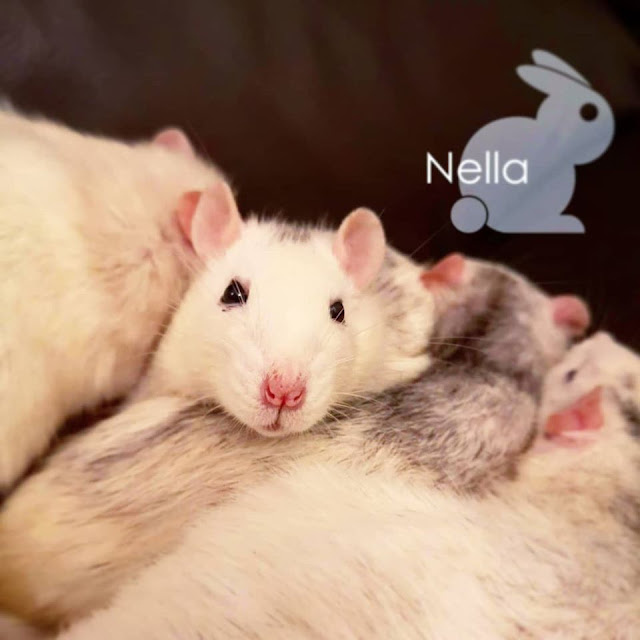Nella
Nella was one of our permanent resident does who arrived with 7 other rats on the 8th of August 2018. We were actually only supposed to be taking 6 rats from their owner, however, we discovered they were keeping 2 females because they had mammary tumours. Unfortunately, the owner couldn't afford to have the masses assessed to see if they could be surgically removed. We offered to take the other two rats - Nella and Xander - and said we'd be happy to ensure they received prompt medical treatment. Their owner was really touched that we offered to help their rats.
Nella was a strong female and a true fighter. Nothing was ever too much for Nella to handle. She was an absolute trooper.
Mammary Fibroadenoma Excision:
Nella had a large thoracic mammary tumour (likely a fibroadenoma). The vet assessed the tumour and was confident it could be safely removed. So, Nella was booked for surgical excision of the mammary tumour removed on the same day as two other does, Leia and Xander, also having tumours excised.The 3 surgeries went very well, although all rats were relentless gnawers of their surgical sites despite adequate post-op pain relief. We made the decision to have the rats wear buster collars when left unattended. We decided to house the 3 does in the same adapted post-op accommodation to reduce additional stress from isolation.
The three girls recovered very quickly from their surgery and were soon back together as a large mischief.
Dipstick urinalysis highlighted chart-topping levels of haematuria. We cross-checked the results with another rat which did highlight a disparity.We obtained a urine sample to send off for a culture sample. Once the sample had been sent, Nella was introduced to oral NSAIDs and oral trimethoprim-sulfamethoxazole. We noticed a rather sudden improvement to Nella's behaviour. The sudden change was indicative of underlying chronic pain which was alleviated by Metacam as antibiotics generally don't kick in 'suddenly'.
The results were quite surprising. The vet forwarded the results to other exotic specialists for their input. As the results made a urinary tract infection highly unlikely, they were curious if the haematuria was actually coming from Nella's reproductive organs.
An ultrasound highlighted some fluid present within Nella's uterus. So, we opted for an ovariohysterectomy.
Upon removal, Nella's uterus appeared largely normal. There was some enlargement. The vet wondered if Nella had a chronic inflammatory disease which was responding to NSAIDs. There was no evidence of a pyometra.
We discontinued antibiotics at this point. Nella was introduced to oral Tramadol post-op to help with her pain levels.
Spaying Nella did make her noticeably calmer and friendlier towards her cage mates. After some weeks had passed, we decided to test Nella's urine again.
Frustratingly, the tests were saying Nella still had off-the-chart levels of haematuria.
At this point, we were becoming a little concerned. We decided it was necessary to send a urine sample off for cytology. Microbiologists, the exotic vets, and our vet had fears of sterile cystitis, kidney disease, bladder cancer, and bladder polyps.
The results concluded that no haematuria, neoplasia, or inflammation was present. The vet also performed a bladder scan which was unremarkable, although her bladder was small which can mask some issues.
The vet conversed with the microbiologists at the lab about the results. The microbiologist wondered if there was a nutritional aspect to Nella's issues. They also confirmed that dipstick readings for haematuria are reliable but excitable.
Given this new information, we decided to converse with some leading Norway rat nutritionists to see how we could amend our diet. They suggested a low-wheat kidney-friendly shunamite style mix. We wanted to retest Nella's urine after a month or so on her new diet.
We decided to dig even deeper for a possible cause. After all this treatment, Nella was also asymptomatic at this point.
After plenty of research, we concluded that Nella's haematuria may be attributable to mycoplasma and mycoplasmosis. Mycoplasma pulmonis is ubiquitous in rats, and a common symptom is haematuria given its affinity for the respiratory and urogenital tract.
Hind-Leg Degeneration (HLD):
Despite an abundance of complications throughout her time with us, Nella lived to a grand old age of almost 3 years old!
During her final weeks of life, Nella suffered from hind-leg degeneration which essentially means the rat's back legs become weaker until the rat has little use of their hind legs.
Once we could see signs of HLD, we monitored Nella's quality of life very closely. We ensured she had everything she needed on the bottom floor of the cage including food, water, hides, and a litter tray (which we always do anyway).
Nella lived comfortably on the bottom floor for a few weeks. We started to see Nella's old and frail body was struggling to cope with the ongoing degeneration.
Nella was a mentally stubborn and determined rat and probably would've kept going until she was physically unable, but this isn't fair on any animal. We decided to have Nella humanely euthanised.
Nella passed away on the 6th of March 2020.

















Comments
Post a Comment